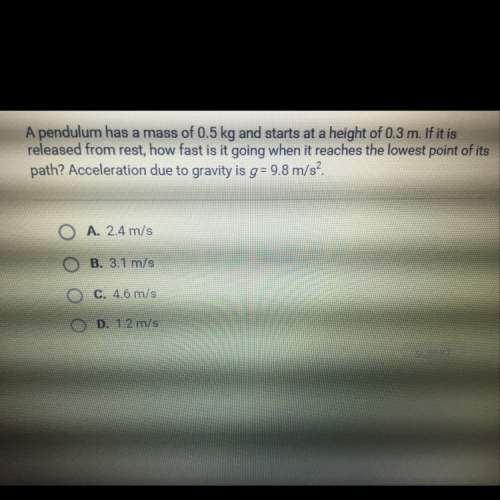
Consider a ball in projectile motion under gravitational force so that it is has motion in both the vertical and horizontal directions. The effects of air friction may be ignored. When the ball reaches the highest point in its trajectory, what can be said about the magnitudes of the ball's velocity and acceleration vectors? Select the correct answer
a. The horizontal components of both the velocity and acceleration are zero.
b. The magnitude of velocity is zero, but the acceleration is a constant
c. The magnitudes of both velocity and acceleration are zero
d. The magnitude of acceleration is zero but the ball has a positive velocity
e. The magnitude of velocity is at its minimum nonzero value, but the magnitude of acceleration is a constant

Answers: 1
Other questions on the subject: Physics

Physics, 22.06.2019 00:30, dondre54
During spring semester at mit, residents of the parallel buildings of the east campus dorms battle one another with large catapults that are made with surgical hose mounted on a window frame. a balloon filled with dyed water is placed in a pouch attached to the hose, which is then stretched through the width of the room. assume that the stretching of the hose obeys hooke's law with a spring constant of 89.0 n/m. if the hose is stretched by 5.80 m and then released, how much work does the force from the hose do on the balloon in the pouch by the time the hose reaches its relaxed length? unitst 3 number-1497 the tolerance is +/-5% open show work click if you would like to show work for this question:
Answers: 2

Physics, 22.06.2019 01:30, romanlittlewood
For problems 1-3, consider a simple dc brush motor with a permanent magnet stator. with an an consider a simple dc brush motor with a permanent magnet ae supply voltage of 100 v, the no-load speed of the motor is 1000 rpm. this motor can provide a torque of 1.9 n-m at 800 rpm drawing a current of 2 a current are both zero at no load.) 1. with an armature supply voltage of 100 v, the motor is operated at 900 rpm. what is the motor torque? what is the mechanical power delivered by the motor? what is the current draw? what is the electrical power input? what is the energy efficiency of the motor? with an armature supply voltage of 100 v, the motor is operated at 1100 rpm (where it acts as a generator). what torque input is required? what mechanical power is required what current is generated? what is the electrical power generated? what is the energy efficiency of the motor acting as a generator? 2. with an armature supply voltage raised to 120 v, the motor is operated at 1000 rpm. what is the no-load speed? what is the motor torque? what is the mechanical power delivered by the motor? what is the current draw? what is the electrical power input what is the energy efficiency of the motor? 3.
Answers: 3

Physics, 22.06.2019 18:00, skylarleannjone2751
The protons in a nucleus are approximately 2 ✕ 10^−15 m apart. consider the case where the protons are a distance d = 1.93 ✕ 10^−15 m apart. calculate the magnitude of the electric force (in n) between two protons at this distance.
Answers: 1

Physics, 22.06.2019 19:30, chelseayazzie16
What you see with your eyes is a form of energy. a. light b. heat c. chemical d. electrical
Answers: 2
Do you know the correct answer?
Consider a ball in projectile motion under gravitational force so that it is has motion in both the...
Questions in other subjects:


Arts, 22.11.2020 03:50

Health, 22.11.2020 03:50

English, 22.11.2020 03:50

Mathematics, 22.11.2020 03:50


Biology, 22.11.2020 03:50


Mathematics, 22.11.2020 03:50








